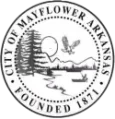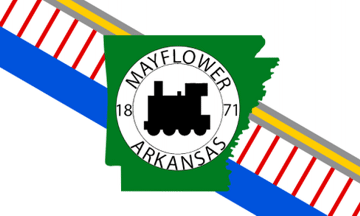The key design principles establish essential goals for development in the Heart of Mayflower district to ensure sustainability and visual quality of this unique environment. Buildings shall be located and designed so that they provide visual interest and create enjoyable, human-scaled spaces. The key design principles are:
- New buildings/building facades shall utilize building elements and details to achieve compatibility with existing buildings in the Heart of Mayflower district.
- Compatibility is not meant to be achieved through uniformity, but through the use of variations in building elements to achieve individual building identity.
- Building facades must include appropriate architectural details and ornament to create variety and interest.
- Buildings shall be built to, or close to, the sidewalk to define and enhance the pedestrian environment. The Regulating Plan shall establish the framework within which new buildings shall be constructed.
- Open space(s) shall be incorporated to provide usable public areas integral to the downtown environment.
(a) The following design standards and guidelines shall provide property owners, developers, city staff, and decision makers adequate design guidance for new and existing commercial and mixed use buildings.
1. Location on the street.
(A) Buildings shall be oriented toward the major street front with the primary entrance located on that street. All primary entrances shall be oriented to the public sidewalk for ease of pedestrian access.
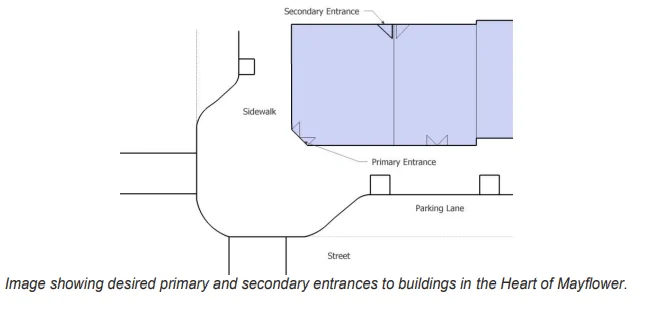
(B) At key intersections buildings located on corner lots shall utilize variations in building massing to emphasize street intersections as points of interest in the district. Maximum building heights shall be permitted to exceed by twenty-five percent (25%) for approximately twenty-five percent (25%) of the building frontage along each street façade.
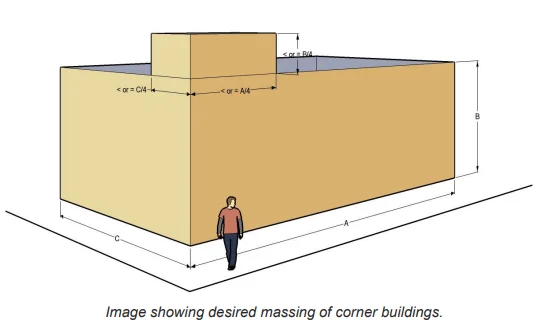
2. Pedestrian-Friendly Building Massing and Scale
- (A) A building’s massing shall serve to define entry points and help orient pedestrians.
- (B) Buildings and/or facades shall emphasize and frame or terminate important vistas.
- (C) Non-residential and mixed use buildings in Mixed Use Center Zone, to the extent practical, shall maintain a twenty-five feet (25’) to thirty-five feet (35’) building facade widths or multiples thereof.
- (D) Variations in the rhythms within individual building facades shall be achieved within any block of building facades with architectural elements such as bays, columns, doors, windows, etc.
- (E) Breaks in the predominant rhythm may also be used to reinforce changes in massing and important elements such as building entrances, terminated vistas, or corner sites.
- (F) Porches, stoops, eaves, awnings, blade signs, arcades, colonnades and balconies should be used along commercial storefronts and they may protrude beyond the setback line provided that they do not inhibit pedestrian movement within the public right-of-way. Balconies shall have external bottom supports.
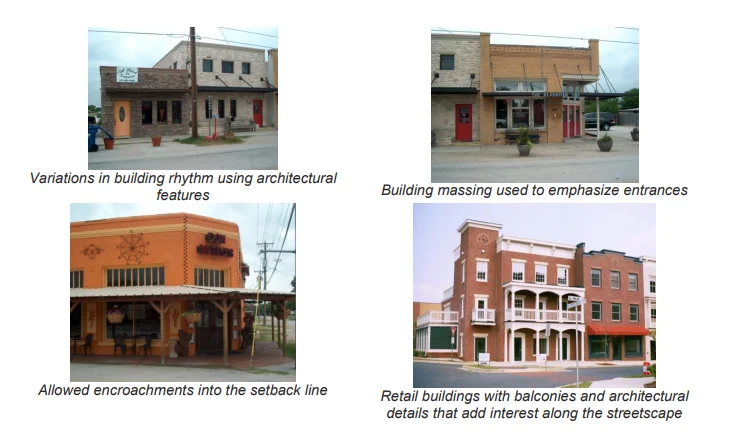
(3) Architectural Elements and Storefronts.
(A) Architectural elements shall be designed to the appropriate scale and proportions of the selected architectural style. For example, building designs based an Art Deco style shall utilize architectural elements of a scale and proportion characteristic of that style.
(B) An expression line or equivalent architectural element shall delineate divisions between floors of all buildings, and a cornice shall delineate the tops of facades that do not utilize a pitched roof. For retail storefronts, a transom, display window area and bulkhead at the base shall be utilized.
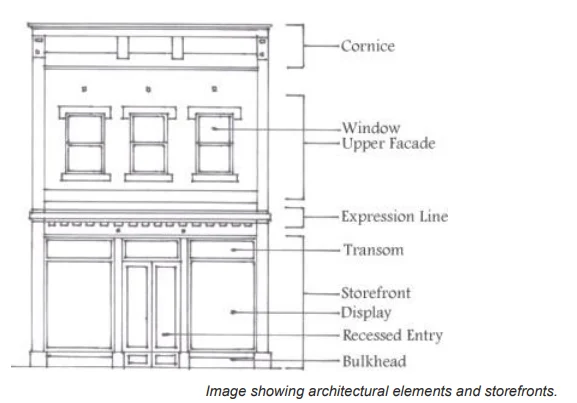
(C) Building entrances may be defined and articulated by architectural elements such as lintels, pediments, pilasters, columns, porticos, porches, overhangs, railings, balustrades, and others as appropriate. All building elements should be compatible with the architectural style, materials, colors, and details of the building as a whole. Entrances to upper level uses may be defined and integrated into the design of the overall building facade.
(D) Roofs. Flat roofs enclosed by parapets or sloped roofs shall be used to screen rooftop mechanical equipment. Mansard roofs and flat membrane type roofs that are visible are prohibited.
(E) Doors and Windows. Generally, windows shall be oriented vertically, and bay windows shall have external bottom supports. Dormer windows shall also be vertically proportioned and slightly shorter than the windows below. In order to provide clear views of merchandise and perceived
connections.
(F) Transparency Required. For all new Mixed Use and Commercial construction and renovation, the street-level floor in the Mixed Use Center Zone shall have transparent storefront windows covering no less than fifty percent (50%) of the façade area. Each floor of all building façades facing a street or plaza shall contain transparent windows covering at least fifteen percent (15%) of the façade area.
(G) Ground floor retail building plate heights generally shall be at least fifteen feet (15’) in height.
(H) Storefronts. Retailers located at the street level shall primarily use storefronts to orient and advertise merchandise to customers. Retail buildings shall provide street-level pedestrian-oriented uses at the ground floor level. Storefronts on facade treatments that span multiple tenants shall use architecturally compatible materials, colors, details, awnings, signage, and lighting fixtures.

(I) Design of Structured Parking Facilities:
a. All frontages of parking structures located within the Mixed Use Center and Creekside Zones shall not have parking uses on the ground floor to a minimum depth of 30 feet along the street frontage. Or, garages shall be set back a minimum of 30 feet in order to allow for a future liner building along the garage frontage.
b. The amount of street frontage devoted to a parking structure shall be minimized by placing the shortest dimension(s) along that street edge(s).
c. Parking structure facades adjacent to public right of way in Mixed use Center and Creekside Zones shall be designed with both vertical (façade rhythm of 20 feet to 30 feet) and horizontal (aligning with horizontal elements along the block) articulation.
d. Where above ground structured parking is located at the perimeter of a building with frontage along a street; it shall be screened in such a way that cars on all parking levels are completely hidden from view from all adjacent public streets. Parking garage ramps shall not be visible from any public street. Unless site conditions do not allow or if an alternative design achieves the screening requirements, ramps shall not be located along the perimeter of the parking structure. Architectural screens shall be used to articulate the façade, hide parked vehicles, and shield lighting.
e. When parking structures are located at corners, corner architectural elements shall be incorporated such as corner entrance, signage and glazing.
f. Parking structures and adjacent sidewalks shall be designed so pedestrians are clearly visible to entering and exiting automobiles.

(4) Building Materials.
(A) At least eighty percent (80%) of the street facing (except alleys) facades of all new buildings (excluding doors and windows) shall be finished in one or more of the following materials:
• Masonry (brick, stone, cast stone, rock, marble, granite, glass block and/or tile);
• Cementitious-fiber clapboard (not sheet) with at least a fifty (50) year warranty;
• Split face concrete block or poured-in-place concrete;
• Up to twenty percent (20%) Architectural Metal, Wood or Exterior
• Insulating Finishing System (EIFS) as an accent only;
• Roofing materials (visible from any public right-of-way): copper, factory finished painted metal, slate, synthetic slate, terra cotta, cement tile, glass fiber shingles or materials with similar durability.
(B) Side facades and rear facades shall be of finished quality and of the same color that blend with the front of the building, but are not required to be the same material. Rear facades may be painted tilt-wall or painted block matching the same color of the rest of the building if the rear façade faces an alley or is not viewable from a public street or right-of-way.
(b) The following design standards and guidelines shall provide property owners, developers, city staff, and decision makers adequate design guidance for residential buildings types:
(1) Location on the street.
(A) All primary entrances shall address the primary street unless configured as a courtyard building.
(B) Garages generally shall be located on alleys at the rear of residential buildings; pull-through garages are allowed if the garage door is set back behind the rear façade of the main structure. If front-loaded garages are utilized on single-family residential lots, the garages shall be no greater than twenty four feet (24’) wide, and set back at least ten feet (10’) measured from the face of the main structure closest to the garage or rotated ninety (90) degrees with windows on the wall facing the street. Front-loaded garages on residential lots less than fifty feet (50’) wide shall not be allowed, and shall be loaded from alleys only. Town homes and courtyard apartments shall utilize rear-loaded garages from an alley.

(2) Pedestrian-Friendly Building Massing and Scale.
(A) On residential buildings, at least one of the following shall be utilized: porches, stoops, bay windows, balconies, masonry clad chimneys, attached pergolas or colonnades. Those architectural elements may
encroach beyond the setback line.
(B) The base of a building shall be delineated by a change in color, water mark or different material for at least the first eighteen inches (18”) of the façade; or where feasible, the grade of the slab or first floor elevation shall be elevated at least eighteen inches (18”) above the grade of the sidewalk.
(3) Architectural Elements.
(A) Residential buildings shall have relatively flat fronts and simple roofs with most building wing articulations set at the rear of the structure. Window projections, stoops, porches, balconies, and similar extensions are exempt from this standard.
(B) Gable roofs, if provided, shall have a minimum pitch of 3/12. When hipped roofs are used, the minimum pitch shall be 4/12. Other roof types shall be appropriate to the architectural style of the building. Mansard roofs shall be prohibited.
(C) Architectural embellishments that add visual interest to the roofs, such as dormers and masonry chimneys may be provided

(4) Building Materials.
(A) The following shall be permitted finishes for street fronting facades of all residential buildings and live/work units:
(i) Cementitious-fiber clapboard (not sheet) with at least a fifty (50) year warranty;
(ii) Masonry (brick; stone; man-made stone and stucco utilizing a three-step process).
(B) The following shall be allowed up to twenty-five percent (25%) as an accent material:
(i) Wood;
(ii) Architectural Metal
(iii) Exterior Insulating Finishing System (EIFS)
(iv) Or similar material over a cementitious base, rock, glass block and tile.
(C) Side and rear facades shall be of finished quality and of the same color and durability of materials that blend with the front of the building.
(D) Roofing materials (visible from any public right-of-way): copper, factory finished painted metal, slate, synthetic slate, terra cotta, cement tile, glass fiber shingles or shingles of similar durability.
(E) An enclosed garage or carport shall be designed and constructed of the same material as the primary.
